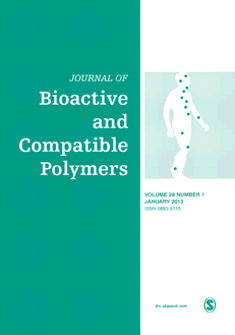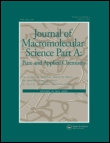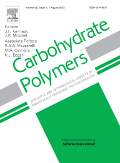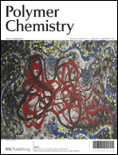
Journal of Materials Chemistry B
Scope & Guideline
Elevating Knowledge Exchange in Materials Chemistry.
Introduction
Aims and Scopes
- Biomedical Materials Development:
The journal publishes research on the design and fabrication of novel materials aimed at medical applications, including biocompatible polymers, hydrogels, and composite materials that can enhance healing, promote tissue regeneration, and serve as drug delivery systems. - Nanotechnology in Medicine:
A significant focus is on the application of nanotechnology to create nanoscale materials that can be used for targeted drug delivery, imaging, and therapy, emphasizing their multifunctionality and responsiveness to environmental stimuli. - Theranostics and Personalized Medicine:
The journal explores theranostic approaches that integrate diagnosis and therapy using advanced materials, particularly in cancer treatment, where materials are designed to target tumors specifically while also providing diagnostic capabilities. - Smart and Responsive Systems:
Research articles often highlight the development of smart materials that respond to physiological conditions (e.g., pH, temperature, redox states) for controlled drug release, enhanced imaging, and improved therapeutic efficacy. - Sustainable and Green Materials:
There is a growing emphasis on the synthesis of biodegradable and environmentally friendly materials, including the use of natural polymers and the development of sustainable manufacturing processes.
Trending and Emerging
- Targeted Nanomedicine and Drug Delivery:
There is a significant increase in research focusing on targeted delivery systems using nanoparticles and nanocarriers, emphasizing their role in enhancing therapeutic efficacy and minimizing side effects in cancer treatment. - Smart Biomaterials for Regenerative Medicine:
Research on smart biomaterials that can dynamically respond to biological stimuli for enhanced tissue regeneration and healing is gaining traction, with a focus on hydrogels and scaffolds that mimic natural tissue properties. - Immunotherapy and Nanoformulations:
The integration of nanotechnology with immunotherapy is a growing area, with studies exploring how engineered nanoparticles can enhance immune responses against tumors and infections. - Biomimetic Approaches in Material Design:
There is an increasing trend towards biomimetic materials that replicate natural structures and functions, aimed at improving biocompatibility and performance in medical applications. - Environmental and Sustainability Considerations:
Research addressing the sustainability of biomedical materials, including the use of biodegradable materials and green synthesis methods, is emerging as a priority in the field.
Declining or Waning
- Traditional Drug Delivery Approaches:
There appears to be a decrease in papers focusing on conventional drug delivery systems without innovative modifications, as the field shifts towards more complex, responsive, and multifunctional systems. - Basic Material Characterization Studies:
Research that solely emphasizes the fundamental characterization of materials without direct applications to biomedical contexts is becoming less prominent, as the journal prioritizes studies that demonstrate practical applications. - In vitro Testing without In vivo Correlation:
There is a noticeable decline in studies that present only in vitro results without subsequent in vivo validation, as the community increasingly recognizes the importance of translating laboratory findings into clinical settings. - General Antimicrobial Studies:
Research focusing on broad-spectrum antimicrobial properties of materials without specific applications or mechanisms is waning, as there is a shift towards more targeted approaches and understanding of specific interactions.
Similar Journals

MACROMOLECULAR RESEARCH
Fostering Collaboration in Macromolecular DiscoveryMACROMOLECULAR RESEARCH, published by the POLYMER SOC KOREA, is a premier journal dedicated to advancing the field of macromolecular science and polymer engineering. With its ISSN 1598-5032 and E-ISSN 2092-7673, this journal has emerged as a vital platform for researchers and professionals interested in the application and development of polymers across various domains. Based in South Korea and operating as an open-access resource since its inception in 2002, MACROMOLECULAR RESEARCH consistently ranks in the Q2 category across diverse fields such as Chemical Engineering, Materials Chemistry, and Organic Chemistry as per the latest 2023 metrics. Notably, it is recognized for its substantial contributions to polymery science, increasing its visibility and impact in global research. By providing a forum for original research articles, reviews, and innovative methodologies, this journal aims to foster collaboration and knowledge sharing among scientists, engineers, and students alike. Join a community that is at the forefront of polymer research by exploring the wealth of resources and cutting-edge studies featured in MACROMOLECULAR RESEARCH.

JOURNAL OF BIOACTIVE AND COMPATIBLE POLYMERS
Pioneering Research in Bioengineering and PolymersJOURNAL OF BIOACTIVE AND COMPATIBLE POLYMERS, published by SAGE PUBLICATIONS LTD, serves as a pivotal platform for disseminating innovative research in the fields of bioengineering, biomaterials, materials chemistry, and polymers. With an ISSN of 0883-9115 and an E-ISSN of 1530-8030, this journal is committed to the advancement of knowledge relating to the interaction of polymers within biological systems and their compatibility in various applications. Operating since 1986, the journal has garnered a respectable presence, ranked in the Q3 quartile across multiple categories in 2023, indicating its relevance and contribution to these dynamic fields. Although not open access, the journal ensures that high-quality research is accessible to subscribers and institutions, reinforcing its importance for researchers, professionals, and students aiming to stay abreast of advancements in polymer science and biocompatibility. By fostering interdisciplinary communication and collaboration, the JOURNAL OF BIOACTIVE AND COMPATIBLE POLYMERS continues to play a crucial role in shaping the future of material applications in health, technology, and industry.

Journal of Macromolecular Science Part A-Pure and Applied Chemistry
Advancing the Frontiers of Macromolecular ScienceWelcome to the Journal of Macromolecular Science Part A - Pure and Applied Chemistry, a distinguished publication dedicated to advancing the understanding of macromolecular science, encompassing critical areas such as polymers, materials chemistry, and composites. Published by Taylor & Francis Inc, this journal has firmly established its place within the scientific community, evident from its ranking in the Q2 and Q3 quartiles across various categories in the latest assessments, including Polymers and Plastics as well as Ceramics and Composites. With a commitment to providing high-quality peer-reviewed content, the journal aims to facilitate knowledge exchange and innovation among researchers and practitioners from around the globe. The absence of open access underscores the journal's commitment to maintaining rigorous editorial standards while remaining accessible to its readership. As the journal converges through valuable research contributions from 1992 to 2024, it continues to be a pivotal resource for professionals and students seeking to explore the latest advancements and applications in the field of macromolecular science.

Materials Today Advances
Exploring groundbreaking research for a sustainable future.Materials Today Advances is a premier open access journal, published by Elsevier, dedicated to disseminating cutting-edge research in the fields of Materials Science and Mechanical Engineering. Since its inception in 2019, the journal has quickly established itself within the academic community, achieving an impressive Q1 quartile ranking in both disciplines as of 2023, indicative of its high-impact contributions. Ranked #25 out of 672 in Mechanical Engineering and #46 out of 463 in General Materials Science according to Scopus, Materials Today Advances offers rigorous peer-reviewed articles that address the latest innovations and interdisciplinary approaches. Researchers, professionals, and students can benefit from the journal's open access model, ensuring widespread visibility and accessibility of groundbreaking findings. With the convergence of advanced materials research and practical applications, this journal represents a vital resource for those at the forefront of scientific discovery.

Frontiers in Bioengineering and Biotechnology
Catalyzing Change through Cutting-Edge ResearchFrontiers in Bioengineering and Biotechnology, published by FRONTIERS MEDIA SA in Switzerland, stands as a leading platform for innovative research and developments in the fields of bioengineering and biotechnology. Since its inception in 2013, this Open Access journal has garnered significant recognition, reflected in its impressive category rankings: Q1 in Biomedical Engineering and Q2 in Bioengineering, Biotechnology, and Histology for 2023. With a focus on fostering collaboration and knowledge sharing, it aims to provide researchers, professionals, and students with access to pioneering studies that push the boundaries of science and technology. The journal, which is indexed in prominent databases, boasts high visibility and impact, evidenced by its impressive rankings across various categories in Scopus. As it continues to converge from 2013 to 2024, Frontiers in Bioengineering and Biotechnology is dedicated to shaping the discourse in its field and promoting advancements that have the potential to transform healthcare and environmental sustainability.

Bioactive Materials
Empowering Researchers with Open Access to Transformative KnowledgeBioactive Materials, published by KEAI PUBLISHING LTD, stands as a leading Open Access journal in the fields of Biomaterials, Biomedical Engineering, and Biotechnology. Since its inception in 2016, this journal has rapidly ascended in prominence, currently holding a prestigious Q1 category ranking across multiple disciplines, reflecting its significant impact within the scientific community. With its E-ISSN 2452-199X, it spans a broad spectrum of research areas, contributing valuable insights to the ongoing discourse in bioactive materials and their applications. The journal's superior Scopus rankings further illustrate its influence, boasting impressive standings in engaging niches such as engineering and molecular biology. Bioactive Materials offers a vital platform for researchers, professionals, and students to disseminate and acquire cutting-edge knowledge, thus fostering innovation and collaboration in the rapidly evolving terrain of biomedicine. Its commitment to Open Access since 2016 enhances accessibility, ensuring that the burgeoning advancements in this field reach a global audience.

Carbohydrate Polymers
Fostering collaboration in polymer research.Carbohydrate Polymers is a prestigious academic journal, published by ELSEVIER SCI LTD, that plays a vital role in the field of materials chemistry, organic chemistry, and polymer science. With its Q1 category rankings in these domains, this journal serves as a critical platform for disseminating high-quality research, innovative methodologies, and significant advancements in carbohydrate-based polymers. Since its inception in 1981 and continuing until 2025, it has fostered critical discussions and collaborations among researchers, professionals, and students worldwide. Although it does not offer open access, its rigorous peer-review process ensures that only the most impactful studies are published. By highlighting new developments in the synthesis, characterization, and application of carbohydrate polymers, Carbohydrate Polymers consistently contributes to the enhancement of knowledge and technology within its field, making it an essential resource for anyone working at the intersection of chemistry and materials science.

ACS Materials Au
Exploring the Frontiers of Materials ScienceACS Materials Au, published by the American Chemical Society, is a premier open-access journal that has been at the forefront of materials science since its inception in 2021. With an ISSN of 2694-2461, this journal encompasses an expansive range of topics including biomaterials, electronic, optical and magnetic materials, materials chemistry, and polymers and plastics, consistently achieving Q1 rankings in these categories for 2023. The journal is based in the United States and operates from the AMS's headquarters in Washington, DC, offering significant visibility and a robust platform for researchers. The journal's commitment to open access ensures wide dissemination of groundbreaking research, enabling a diverse audience—including researchers, professionals, and students—to engage with the latest advancements in materials science. With an encouraging impact factor and a focus on novel materials and innovative applications, ACS Materials Au stands as a vital resource for anyone devoted to understanding and advancing the frontiers of materials engineering and science.

Polymer Chemistry
Advancing the Frontiers of Polymer SciencePolymer Chemistry is a premier peer-reviewed journal published by the Royal Society of Chemistry, focusing on cutting-edge research and developments in the field of polymer science. With its ISSN 1759-9954 and E-ISSN 1759-9962, this journal has established a significant impact within the academic community, as evidenced by its impressive Q1 ranking in areas such as Biomedical Engineering, Organic Chemistry, and Polymers and Plastics. Over its convergence period from 2010 to 2024, Polymer Chemistry has become an essential resource for researchers, professionals, and students, showcasing innovative studies that advance the understanding of polymer behavior and applications. The journal does not currently offer open access, allowing for a traditional but rigorous peer-review process ensuring high-quality publications. For those engaged in the rapidly evolving disciplines of biochemistry and bioengineering, Polymer Chemistry serves as a vital platform for disseminating influential findings and fostering interdisciplinary collaboration in a global context.

JOURNAL OF CONTROLLED RELEASE
Pioneering the future of controlled release technologies.JOURNAL OF CONTROLLED RELEASE is a premier academic journal published by Elsevier that is dedicated to advancing the field of pharmaceutical science with a focus on drug delivery systems. Established in 1984, the journal has consistently served as a vital platform for disseminating high-quality research and innovative ideas in the area of controlled release technologies. With an impressive impact factor and ranking in the Q1 category of Pharmaceutical Science, it ranks #3 out of 183 in Scopus for its field, reflecting its influence and significance within the academic community, as noted by its percentile of 98th. The journal encompasses a wide range of topics, including polymer science, pharmacokinetics, and bioengineering, ensuring it remains at the forefront of pharmaceutical advancements. While currently not offering open access options, the journal serves a diverse audience of researchers, professionals, and students who are eager to push the boundaries of knowledge in drug delivery and therapeutics. For those looking to make impactful contributions in this dynamic field, JOURNAL OF CONTROLLED RELEASE is an essential resource for both foundational studies and cutting-edge research findings.